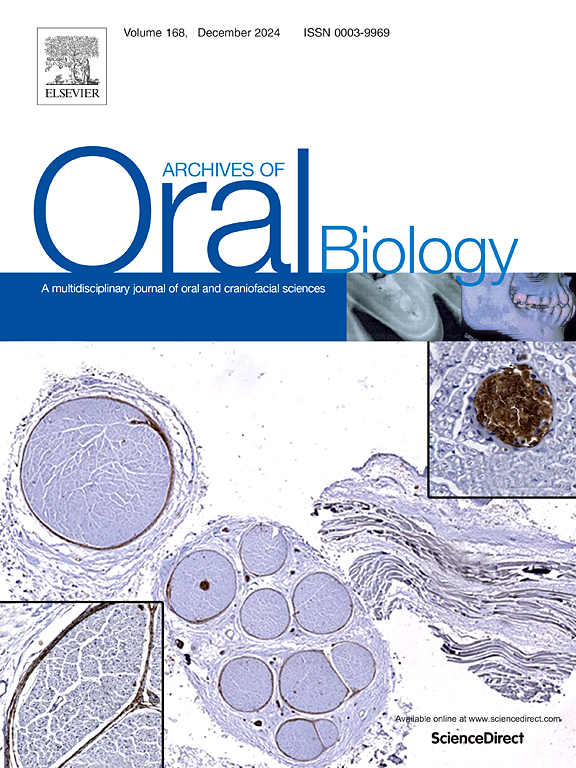Effectiveness in root canal disinfection and biocompatibility of a final in vitro irrigation protocol based on cellulases and a hyperosmotic solution
IF 2.1
4区 医学
Q2 DENTISTRY, ORAL SURGERY & MEDICINE
引用次数: 0
Abstract
Objective
To evaluate the antimicrobial capacity and cell viability of a final irrigation protocol based on the use of a hydrolases enzymes mixture (HEM) and a hyperosmotic solution (HS) as an alternative to conventional protocols.
Methods
Root canals from 28 human first molars were used to develop multispecies anaerobic biofilms in standard reactors and irrigated with various protocols according to the following groups. Group A: control (sterile saline), group B: 2.25 % NaOCl, group C: 1 % NaOCl, group D: HS, group E: 100 U/mL HEM + 1 % NaOCl, group F: 100 U/mL HEM + HS, or group G: 100 U/mL HEM. The disinfection evaluation per group was carried out by CFU counting and Scanning Electron Microscopy (SEM). The viability was determined on fibroblasts.
Results
The F group, which consisted in irrigating with HEM + HS, had a biofilm elimination of over 5.33 (Log reduction), as well as the groups treated with NaOCl with eliminations of up to 5.34 (Log reduction). In addition, the evaluation of viability reflects a biocompatibility of the F group treatment, as opposed to the groups treated with NaOCl.
Conclusions
The irrigation protocols with HEM+HS and HEM+NaOCl turned out to be as efficient as the conventional protocol using NaOCl; moreover, the irrigation protocol with HEM+HS had low cell cytotoxicity in the viability assay when compared to cell cultures exposed to NaOCl.
Clinical significance
It is imperative that new and innovative ways are found for root canal therapy to ensure that the root canal system can be thoroughly cleaned.
根管消毒的有效性和基于纤维素酶和高渗溶液的最终体外冲洗方案的生物相容性。
目的:评价基于水解酶混合物(HEM)和高渗溶液(HS)作为常规方案替代方案的最终冲洗方案的抗菌能力和细胞活力。方法:选用28颗人第一磨牙根管,在标准反应器中培养多种厌氧生物膜,并按不同方案进行冲洗。A组:对照组(无菌生理盐水),B组:2.25 % NaOCl, C组:1 % NaOCl, D组:HS, E组:100 U/mL HEM + 1 % NaOCl, F组:100 U/mL HEM + HS,或G组:100 U/mL HEM。采用CFU计数和扫描电镜(SEM)对各组消毒效果进行评价。在成纤维细胞上测定细胞活力。结果:以HEM + HS冲洗的F组生物膜消除率超过5.33 (Log reduction), NaOCl处理组生物膜消除率高达5.34 (Log reduction)。此外,活力评估反映了F组处理的生物相容性,而不是NaOCl处理组。结论:HEM+HS和HEM+NaOCl灌洗方案与常规NaOCl灌洗方案效果相当;此外,在活力测试中,与暴露于NaOCl的细胞培养物相比,HEM+HS灌溉方案具有较低的细胞毒性。临床意义:寻找新的、创新的根管治疗方法,确保根管系统得到彻底的清洁,势在必行。
本文章由计算机程序翻译,如有差异,请以英文原文为准。
求助全文
约1分钟内获得全文
求助全文
来源期刊

Archives of oral biology
医学-牙科与口腔外科
CiteScore
5.10
自引率
3.30%
发文量
177
审稿时长
26 days
期刊介绍:
Archives of Oral Biology is an international journal which aims to publish papers of the highest scientific quality in the oral and craniofacial sciences. The journal is particularly interested in research which advances knowledge in the mechanisms of craniofacial development and disease, including:
Cell and molecular biology
Molecular genetics
Immunology
Pathogenesis
Cellular microbiology
Embryology
Syndromology
Forensic dentistry
 求助内容:
求助内容: 应助结果提醒方式:
应助结果提醒方式:


